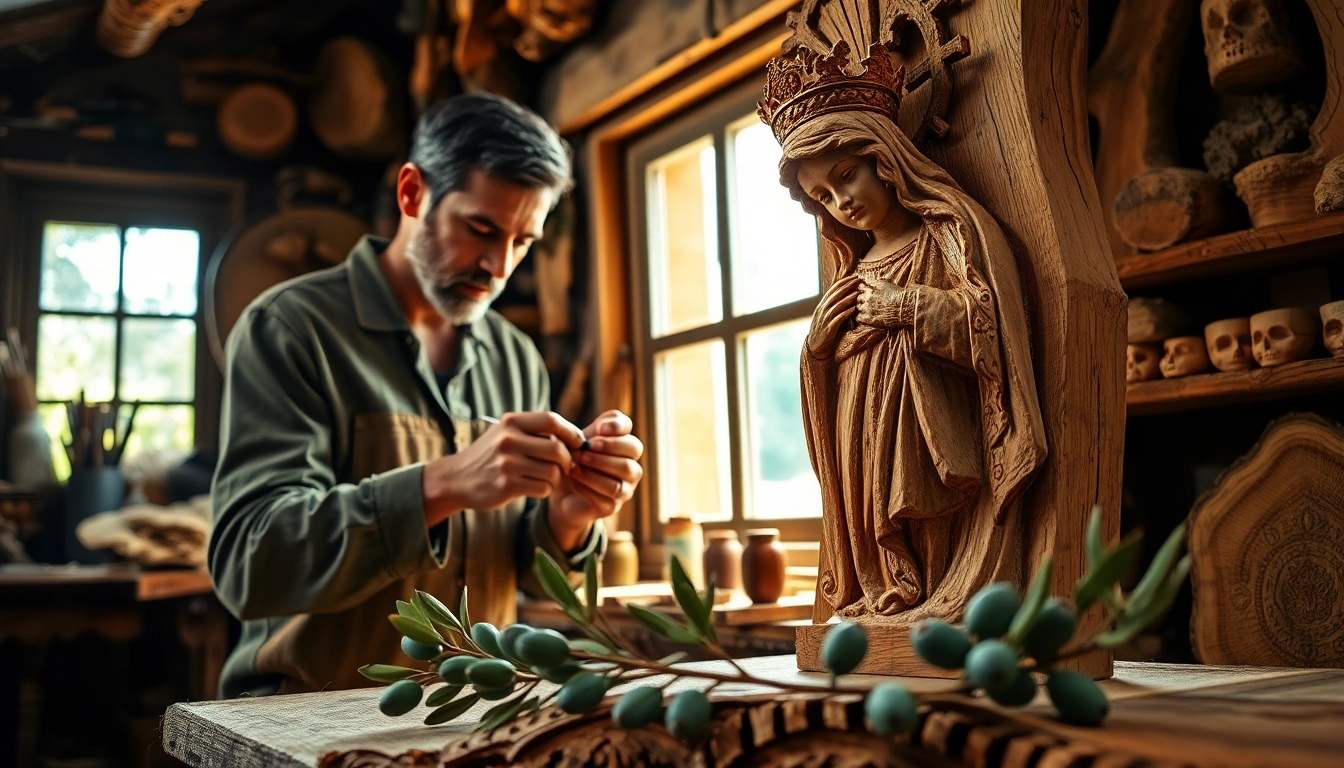1. Introduction to Olive Wood Carvings
Olive wood carvings represent not just a craft, but a deep-rooted tradition that speaks of cultural heritage and artistry. Known for their beauty and versatility, these carvings have gained prominence as cherished items for collectors and art enthusiasts alike. Whether you’re exploring the mystical streets of Bethlehem or browsing online collections, olive wood carvings offer a unique glimpse into history, craftsmanship, and spirituality that resonates with many. In this comprehensive guide, we will delve into the intricacies of olive wood carvings, from their historical significance to the techniques that artisans employ to create these exquisite works of art.
What are Olive Wood Carvings?
Olive wood carvings are artistic representations crafted from the wood of the olive tree (Olea europaea). These carvings can take various forms, including religious figures, abstract sculptures, and decorative items. The unique grain and rich color of olive wood add character to each piece, ensuring that no two carvings are exactly alike. Artisans often utilize the natural curves of the wood, enhancing the aesthetics of their creations by leaving the grain on display.
The Historical Significance of Olive Wood in Art
Olive trees have been revered for thousands of years, particularly in Mediterranean cultures. They symbolize peace, wisdom, and prosperity, making them a fitting medium for artists. The tradition of olive wood carving can be traced back to the early Christian era in the Holy Land, especially in Bethlehem, where artisans have honed their skills through generations. Ancient texts and archaeological findings depict olive wood as a favored material for constructing sacred objects, from religious relics to decorative art. As such, olive wood carvings not only serve as functional pieces but are also steeped in spiritual significance.
Why Choose Olive Wood Carvings for Your Collection?
Choosing olive wood carvings for your collection comes with several advantages:
- Unique Aesthetic Appeal: Each carving showcases the distinct grain patterns and colors of olive wood, offering a one-of-a-kind piece.
- Cultural Heritage: Owning an olive wood carving connects you to the rich history and tradition of craftsmanship in the Holy Land.
- Versatile Use: Whether as decorative art, gifts, or religious items, olive wood carvings fit seamlessly into various aspects of life.
- Sustainable Craftsmanship: Olive wood is often sourced from pruned branches, making it an eco-friendly choice that respects nature.
2. The Art of Olive Wood Carving
Traditional Techniques Used by Artisans
Olive wood carving is not just about cutting wood; it involves a delicate process that translates passion and skill into art. Artisans employ ancient techniques that have been passed down through generations. One notable technique is the “chisel and mallet method,” where artisans use specific chisels and a mallet to shape the wood precisely. Additionally, some artisans incorporate intricate inlay work, which adds further depth and complexity to their pieces.
Tools and Materials Required for Carving
The tools used in olive wood carving mirror those used in traditional woodworking and include:
- Chisels: Various types and sizes for shaping detailed features.
- Mallets: Used to strike chisels and facilitate precise carving.
- Sandpaper: To smooth the finished product and enhance its natural beauty.
- Wood Finish: Natural oils or wax to preserve and protect the wood.
Steps Involved in Creating Olive Wood Carvings
The process of creating olive wood carvings generally involves several steps:
- Choosing the Right Wood: Artisans select high-quality olive wood with desirable grain patterns.
- Designing the Carving: Initial sketches and designs are made to guide the carving process.
- Shaping the Wood: Using chisels and mallets, artisans carve away excess wood to form the desired shape.
- Smoothing the Surface: Once the rough form is achieved, sandpaper is used to smooth the surface and enhance the finish.
- Final Touches: The carving is treated with natural oils or wax to nourish and protect the wood.
3. Popular Themes and Styles in Olive Wood Carvings
Religious and Spiritual Figures
One of the most prevalent themes in olive wood carvings stems from religious narratives, particularly in Christianity, Judaism, and Islam. These include depictions of key figures such as Jesus Christ, the Virgin Mary, angels, and other saints. Many artisans focus on crafting nativity scenes, crucifixes, and religious icons, often incorporating symbolism that resonates with spiritual beliefs. The craftsmanship involved provides not only decorative appeal but also a source of inspiration and reflection for those who appreciate the divine.
Abstract and Modern Interpretations
In contrast to traditional religious themes, some artists explore modern artistic expressions through olive wood carving. Abstract interpretations can result in stunning sculptures that challenge perceptions and evoke emotional responses. These pieces may incorporate asymmetrical designs, unique textures, and non-representational forms, allowing collectors to experience the beauty of olive wood in a contemporary context.
Custom Olive Wood Carvings: Personalization Options
Custom olive wood carvings offer individuals the chance to own unique pieces that reflect their personal stories or experiences. Artisans often work closely with clients to create bespoke items that can range from personalized sculptures to customized religious icons. Common personalization options include engraving names or dates, selecting specific themes, or adjusting sizes to fit specific display areas. This attention to detail ensures that each piece carries significant sentimental value.
4. Caring for Olive Wood Carvings
Cleaning and Maintenance Tips for Your Carvings
To ensure the longevity of olive wood carvings, proper care and maintenance are essential. Here are some practical tips:
- Dust Regularly: Use a soft cloth to dust your carvings regularly, preventing any buildup that could dull the surface.
- Avoid Excess Moisture: Keep olive wood carving away from direct sunlight and humidity to prevent warping or cracking.
- Use Natural Cleaners: When needed, a damp cloth with a mild soap can help clean the surface without causing damage.
Preserving the Quality and Longevity of Olive Wood
Preserving the integrity of olive wood carvings requires a proactive approach:
- Oil Treatment: Periodically applying food-grade mineral oil or beeswax can nourish the wood, ensuring it retains its beauty.
- Temperature Control: Maintain a stable environment for your carvings, avoiding drastic temperature fluctuations.
- Storage Considerations: If storing your carvings, choose breathable materials like cotton to prevent moisture buildup.
Displaying Olive Wood Art in Your Home
Displaying olive wood carvings not only enhances your living space but also showcases your appreciation for art. Consider the following when arranging your carvings:
- Lighting: Soft, indirect lighting can highlight the natural beauty of the wood grain.
- Showcase Levels: Use shelves or stands that create dynamic heights, allowing each piece to catch the eye.
- Complementary Decor: Pair olive wood carvings with textiles or materials that enhance their organic feel, such as linen or stone.
5. Where to Purchase Authentic Olive Wood Carvings
Top Online Retailers for Olive Wood Art
The market for olive wood carvings has expanded with the advent of e-commerce, providing access to authentic pieces from various artisans worldwide. Notable online retailers include:
- Holy Land Gift Shop – Specialized in handcrafted olive wood items made by local artisans.
- Bethlehem Handicrafts – Offers a wide range of olive wood carvings and supports the local economy.
- My Jerusalem Store – Features a diverse collection of olive wood art and decor.
Supporting Local Artisans and Fair Trade Practices
When purchasing olive wood carvings, consider supporting local artisans who rely on this craft for their livelihood. Fair trade practices ensure that artisans receive fair compensation for their work, promoting sustainable economic development in their communities. Look for certifications and labels that confirm ethical sourcing, which not only enriches your home but also contributes to the flourishing of traditional craftsmanship.
Understanding Pricing and Value of Olive Wood Carvings
The pricing of olive wood carvings can vary considerably based on several factors, including the complexity of the design, size, and the artisan’s skill level. Generally, more intricate pieces or larger sculptures command higher prices due to the time and craftsmanship involved. When evaluating the value of a piece, consider not only the aesthetic appeal but also the story and significance behind it.
In conclusion, olive wood carvings continue to captivate hearts and minds, serving as a testament to the beauty of ethical art. By understanding their history, the artistry involved, and proper care, you can appreciate and cherish these unique pieces for years to come.



